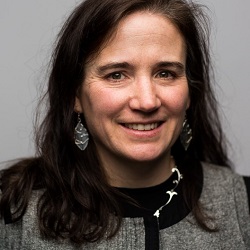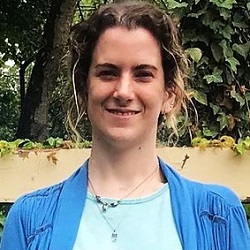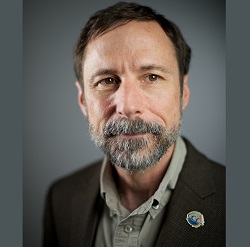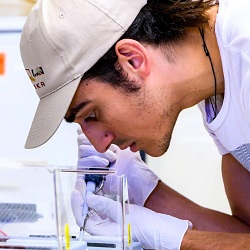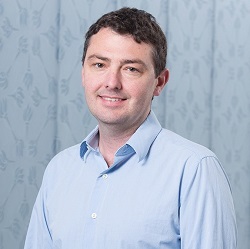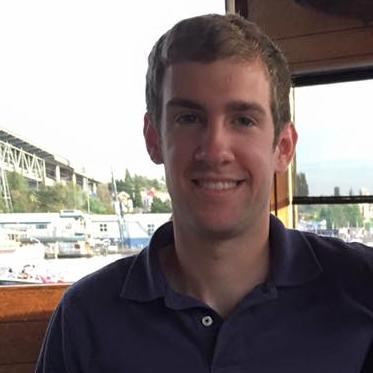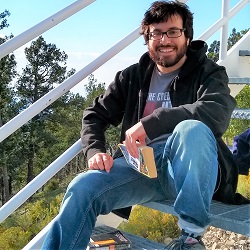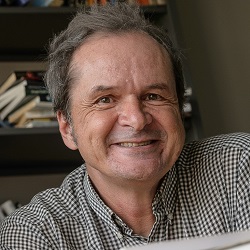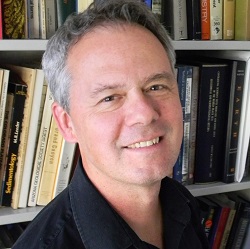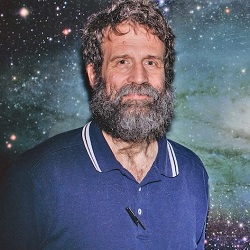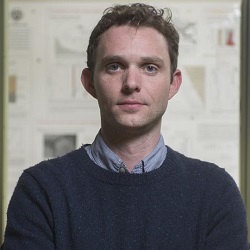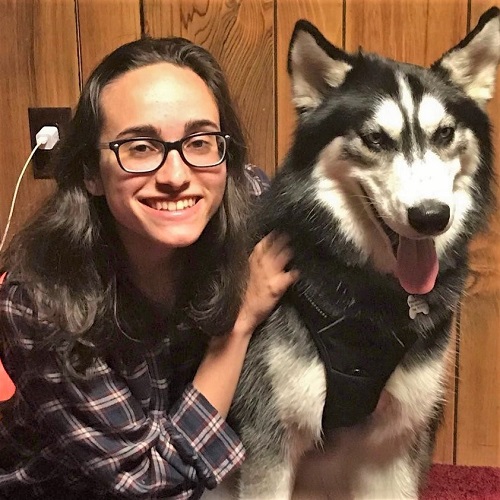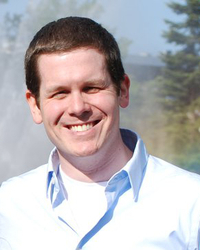This task addresses the nature and distribution of habitable worlds in the universe. Using observational data and models, the VPL team explores the interdependent effects of galactic, stellar, planetary processes on planetary habitability. These include gravitational interactions between the Galaxy and planetary system, gravitational and radiative interaction between the planet, planetary system and host star; and interactions within elements of the planet’s own environment, including the planetary interior, atmosphere, and biosphere.
Theoretical models enable the exploration of diverse, but plausible, exoplanetary environments in advance of more challenging observations. These models can address fundamental questions: How do habitable planets form and evolve? What is the diversity of terrestrial planetary environments? What are the characteristics of planetary systems that support habitable planets? Understanding which planets are more likely to be habitable informs the search for life, develops testable hypotheses, improves interpretation of observations, and informs future instrument development.
Factors Affecting Habitability
Planetary habitability is the outcome of the interplay of processes between the planet, planetary system, and host star, which we have studied extensively. These include gravitational interactions, which can affect volatile delivery during formation (e.g. Raymond et al., 2007), migration (Gillon et al., 2017; Luger et al., 2017b), tidal heating (e.g. Barnes et al., 2013; Barnes et al., 2018), orbital evolution (Deitrick et al., 2015; Barnes et al., 2015), spin state and obliquity (Deitrick et al.,2018a,b), and planet-planet interactions (Armstrong et al., 2014; Barnes et al., 2015); interaction between the planet and the host star’s spectrum and activity levels, which affect atmospheric and ocean loss (Raymond et al., 2006; Luger and Barnes, 2015; Luger et al., 2015, Lincowski et al., 2018), climate (Meadows et al., 2018, Lincowski et al., 2018), photochemistry and surface habitability (Segura et al., 2003, 2005, 2010; Arney et al., 2017); and interactions between aspects of the planet’s own environment, including its interior, atmosphere, and biosphere (Driscoll and Barnes, 2015). These interactions govern the planet’s evolutionary trajectory, and have a larger and more diverse impact on a planet’s habitability than its position in the habitable zone. For M dwarf habitable zone planets, models suggest that evolutionary processes may desiccate them early on (Luger and Barnes, 2015; Barnes et al., 2018), leaving behind O2-, N2– or CO2 -rich atmospheres, which can strongly affect climate. These evolutionary processes can produce uninhabitable planets in the habitable zone and leave tell-tale signs of evolutionary impact in their planetary spectra (Meadows et al., 2018, Lincowski et al., 2018). In this Task, we develop the coupled models required to simulate the formation, migration, evolution, and current atmospheric states of habitable zone terrestrial and volatile-rich planets with secondary outgassed atmospheres, providing the first multi-parameter, end-to-end picture of terrestrial planet habitability.
VPL research has made significant advances in understanding the factors and evolutionary processes affecting terrestrial planet habitability. In addition to the work described above, we have set the community’s habitable zone (HZ) standard (Kopparapu et al., 2013), and used 3D models to define M dwarf HZ limits (Kopparapu et al., 2016). We showed that M dwarf planets are less susceptible to glaciation, and may recover more easily (Shields et al., 2013, 2014), that high surface temperature CO2/H2O-rich atmospheres could exist within the HZ (Wordsworth and Pierrehumbert, 2013), and that multiple stable habitable or uninhabitable states could occur for a HZ water world (Goldblatt, 2015). We described how obliquity evolution can extend the range of habitable orbits (Armstrong et al., 2014) or eliminate habitability throughout the HZ (Barnes et al., 2015), depending on planetary architecture. We discovered that tidal heating could drive a runaway greenhouse on M dwarf HZ planets (Barnes and Heller, 2013) and may shut down the generation of a magnetic field (Driscoll and Barnes, 2015). We showed that stellar evolution might remove an M dwarf planet’s ocean early on (Luger and Barnes, 2015), or enable habitability for a migrated planet by removing its hydrogen shroud (Luger et al., 2015). We used our evolution modeling suite to assess the impact on Proxima b’s habitability due to stellar evolution, planet-planet perturbation, tidal heating, and interior and atmospheric evolution (Barnes et al., 2018). Meadows et al. (2018) used these evolutionary scenarios to generate self-consistent climate-photochemical states for a diversity of atmospheres, to assess potential habitability, generate thermal phase curves and spectra, and identify observational discriminants – such as collisionally induced absorption from O2 and strong CO2 bands – that might indicate the evolutionary trajectory and current state of the planet.
While habitability studies have widespread applicability to planetary systems orbiting stars of several spectral types, we focus significantly on terrestrial-sized planets orbiting M dwarfs, as these are the first planets to be found in the habitable zone (e.g. Proxima Centauri b, TRAPPIST-1 e, f, and g, and LHS 1140 b), and potentially amenable to telescopic follow-up observations, particularly by the James Webb Space Telescope. Topics that we are continuing to explore include planet formation around low-mass stars, the role of stellar migration through the galaxy, the orbital stability of planetary systems, and studying exoplanet habitability using a diverse set of climate and photochemistry models. These studies will help our team form an interdisciplinary framework for assessing habitability that we will use to prioritize newly-discovered planets for spectroscopic follow-up, to search for signs of habitability and life.
Recent VPL scientific highlights from this research area include:
The Evolution of Terrestrial Planets
VPL has produced VPLanet, a software suite that simulates planetary system evolution, with a focus on habitability. Parameterized physical models, typically consisting of ordinary differential equations, are coupled together to simulate evolution over the entire age of a planetary system. These models currently include galactic tidal perturbations, stellar evolution and a planet’s thermal atmospheric escape, the orbital evolution of the planetary system, including circumbinary planets (i.e. a planet orbiting around binary stars), planetary rotational axis evolution, tidal heating, interior radiogenic heating, and an energy balance climate model.
VPLanet has been used to comprehensively assess the potential for habitability of Proxima Centauri b, particularly its potential galactic evolution considering nearby stars Alpha Centauri A and B, tidal locking of b, and considering the atmospheric escape of any primordial atmosphere and the planet’s potential internal thermal history (Barnes et al., 2018). This model has also been used in studies targeting the possibility of planets in binary star systems, demonstrating possible mechanisms for the lack of observed circumbinary planets (Fleming et al., 2018). Other orbital factors can affect habitability, such as the oscillation of a planet’s obliquity (its axial tilt) and orbital eccentricity (Milankovitch cycles) and can induce a variety of climate states, which could curtial a planet’s habitability in the habitable zone (Deitrick et al.,2018a,b).
Tidal effects on planetary habitability have been studied extensively by VPL. We have pioneered the concept of “The Tidal Habitable Zone”, a region around an M dwarf in which a planet does not gain too much or too little planetary heating due to tidal effects (Barnes et al., 2008), as these planets with significant tidal heating can be forced into a runaway greenhouse within the classical habitable zone for up to a billion years (Barnes et al., 2013). We have also explored the effects of tides on planetary obliquity (Heller et al., 2011) and determined that the spin properties of habitable planets can be modified by tides if the planets have large eccentricities, even for planets orbiting in the habitable zone of solar-mass stars where tidal forces are typically weaker. For brown dwarfs we find that planets have relatively short residence times in the habitable zone and hence have a decreased likelihood for habitability (Bolmont et al., 2011). We are also exploring the possibility that tidal heating may be strong enough on planets orbiting low-luminosity M dwarfs that a runaway greenhouse is triggered on planets in the traditional radiative habitable zone (Barnes et al., 2013).
Planetary Environmental States and Observational Discriminants
VPL leads the field in forward modeling terrestrial planet environments, their atmospheres, factors affecting habitability, biosignatures, and observational discriminants (spectral signatures). We include factors such as geological outgassing, biological surface fluxes, the wavelength-dependent reflectance of different surfaces and the associated effects on habitability and detection of biosignatures in reflectance spectra, photochemistry-induced changes to planetary atmospheres as a result of different host stars, including flares, and the affects of aerosols, such as condensed clouds and photochemical hazes, on both climate and detectability.
Stellar Radiative Effects On Planetary Habitability
We have calculated the effects of a large flare from a cool M dwarf star (AD Leonis) on an Earth-like planetary atmosphere (Segura et al., 2010). A similar approach was applied to atmospheres with 0.2 bars of CO2 for an abiotic planet, with no biogenic surface fluxes (Sánchez-Flores and Segura, 2011). The results from these “early Earth” type atmospheres suggest that planets around active M dwarfs with CO2 atmospheres may be better protected from the UV radiation of their parent stars than planets around sun-like stars even without the presence of biologically produced O2. This is because the quiescent flux from the star photolyzes CO2 to produce O2 and O3 with column depths an order of magnitude larger than for an Earth-like planet around the Sun. During a stellar flare the abundances of O2 and O3 do not change significantly, and the UV stellar radiation that reaches the planetary surface is less than that for a similar planet around the Sun.
We are also working to understand the typical flaring rate for different types of stars. We used the first quarter of Kepler observations to identify flare events in the cool K and M dwarfs in the Kepler sample, stars that were not preselected for their level of activity. We found many such events and, most interestingly, found that stars with long-duration flares (four hours or more) spend less time flaring overall (Walkowicz et al., 2011). This indicates that some planets may be subjected to less frequent but longer duration changes in the spectral energy distribution of the stellar flux, while others experience more frequent but short duration changes.
Repeated flares over time can completely depress the ozone abundance, particularly if the UV radiation of the flares is accompanied by the generation of protons, which can destroy ozone through NOx catalytic cycles (Tilley et al., 2019).
A Diversity Of Planetary Atmospheres
Planet discoveries by Kepler and other campaigns have shown that planets very unlike those in our Solar System exist in the Galaxy. The large number of M dwarf stars and likely associated planets indicates that small planets unlike the bodies in our Solar System may be very abundant. VPL has considered different types of planetary environments, particularly those unlike Earth that could harbor life, and those that may not be habitable, but exist in the habitable zone.
In comprehensive studies of Proxima Centauri b (Meadows et al., 2018) and the seven-planet TRAPPIST-1 system (Lincowski et al., 2018), we have considered both O2– and CO2-dominated atmospheres that may form and be stable for these planets, even in the habitable zone. The dense O2 atmospheres could be false positives for life, but we have demonstrated observational discriminants, particularly O2-O2 collision-induced absorption, that may serve to identify these atmospheres (Schwieterman et al 2016). Venus-like planets may be a common evolutionary outcome (e.g. Kane et al., 2014, Meadows et al., 2018, Lincowski et al., 2018), and in these climate and spectral studies, we have shown how difficult it may be to identify these planets with JWST. Venus-like photochemical processes may be robust around M dwarf stars, but a planet like TRAPPIST-1 b – with only twice the insolation of Venus – may be too hot to condense Venus-like sulfuric acid aerosols, leaving open the possibility of a clear-sky Venus-like planet, which could be easily characterized by JWST (Lincowski et al., 2018).

Click to See Researchers Working on This Task
Email: abbot@uchicago.edu Website CV VPL Focus: Task B
Bio: I use mathematical and computational models to understand and explain fundamental problems in Earth and Planetary Sciences. I have worked on problems related to climate, paleoclimate, the cryosphere, planetary habitability, and exoplanets, but I’m always excited to think about new things. I work best with students who have strong mathematical skills that they want to apply to cool problems. Recently I’ve been focusing a lot of effort on terrestrial exoplanets and habitability. We have a really great community with three faculty in our department and three in astronomy working on exoplanets.
Email: jcarmstrong@weber.edu
VPL Focus: Task C
Bio:
My primary research focus is working with the Virtual Planetary Laboratory to help characterize the properties of planets around other stars. In addition, I analyze data from several Mars missions to explore the history of the Martian climate. I am also interested in problems related to high performance computing and visualization
Email: bitz@atmos.washington.edu
VPL Focus: Task C
Bio:
I am interested in the role of ice in the climate system and high-latitude climate and climate change, brupt climate change, coupled biological-climate systems, and global coupled climate modeling.
Email: avb5903@psu.edu
VPL Focus: Task C
Bio:
I study ion escape from Venus, which lacks an intrinsic magnetic field. Solar radiation ionizes molecules near the top of the atmosphere. The Venusian ion environment and the magnetized solar wind both generate electric fields, which can accelerate ions away from the planet. My work addresses the energy deposition associated with localized plasma wave transport across the solar wind shock region into Venus’s atmosphere.
Email: meadows@uw.edu
Website:
Bio:
Victoria Meadows is an astrobiologist and planetary astronomer whose research interests focus on acquisition and analysis of remote-sensing observations of planetary atmospheres and surfaces. In addition to studying planets within our own Solar System, she is interested in exoplanets, planetary habitability and biosignatures. Since 2000, she has been the Principal Investigator for the Virtual Planetary Laboratory Lead Team of the NASA Astrobiology Institute. Her NAI team uses models of planets, including planet-star interactions, to generate plausible planetary environments and spectra for extrasolar terrestrial planets and the early Earth. This research is being used to help define signs of habitability and life for future extrasolar terrestrial planet detection and characterization missions.
Email: benjamin.charnay@lmd.jussieu.fr
VPL Focus: Task B, Task C, Task E
Bio:
My research topic is the physics and dynamics of planetary atmospheres. I have been focussing on the dynamics of Titan’s troposphere and the climates of the early Earth. Now, I am also studying the atmospheres and climates of exoplanets (i.e. dynamics, photochemistry, clouds and haze). I study these atmospheres with 3D Global Climate Models (GCMs).
Research interests:
- Titan’s troposphere (dynamics, planetary boundary layer, surface winds and dune formation)
- Climatic evolution of Titan
- Climates of the early Earth (faint young Sun problem and formation of organic haze)
- Habitability of exoplanets
- Exoplanetary atmospheres (super-Earths and Neptune-size planets)
Email: mc229@st-andrews.ac.uk
VPL Focus: Task B, Task C
Bio:
I work on improving models of terrestrial planets, with the aim of reducing uncertainties in our ability to interpret spectra of extrasolar planets. I work with the VPL photochemical and climate models, and am broadly interested in questions of atmospheric evolution and planetary habitability.
Selected publications:
Claire, M.W. , Sheets, J., Cohen, M., Ribas, I., and Catling, D.C., “The evolution of solar flux from 2 nm to 160 microns: quantitative estimates for planetary studies” Astrophysical Journal, in press, 2012.
Zerkle A., Claire M., Domagal-Goldman S., Farquhar J., and Poulton S. “A bistable organic-rich atmosphere on the Neoarchaean Earth, Nature Geosciences, 2012. DOI: 10.1038/NGEO1425.
Domagal-Goldman, S.D., Meadows, V.C, Claire, M.C., Kasting, J.F. “Astronomical biosignatures for sulfur-rich anoxic biospheres.” Astrobiology, 11(5), 2011.
Beal, E., Claire, M, and House, C.. “High rates of anaerobic methanotrophy at low sulfate concentration with implications for past and present methane levels” Geobiology, DOI: 10.1111/j.1472-4669.2010.00267.x, 2011.
Tian, F., Claire, M., Haqq-Misra, J., Smith, M.,Crisp, D., Catling, D., Zahnle, K., Kasting, J. . “Photochemical and climate consequences of sulfur outgassing on early Mars.” Earth and Planetary Sciences Letters, 295 (3-4), 412-418, 2010.
Catling, D.C., Claire, M. W., Zahnle, K. J., Quinn, R. C., Clark, B. C., Hecht, M. H., Kounaves, S. “Atmospheric origins of perchlorate on Mars and in the Atacama”, J. Geophys. Res., 115,E00E11, 1-15, 2010
Marion, G.M., Catling, D.C., Zahnle, K.J., and Claire, M.W. “Modeling aqueous perchlorate chemistries with applications to Mars”, Icarus, 207 (2) 675-685, 2010.
Goldblatt C., Claire, M. , Lenton, T. , Matthews, A., Watson, A., Zahnle, K. “Nitrogen-enhanced greenhouse warming on the early Earth” Nature Geosciences, 2 (12), 891-896, 2009.
Catling, D.C., Claire, M.W., and Zahnle, K.J., “Anaerobic methanotrophy and the rise of atmospheric oxygen” Philosophical Transactions of the Royal Society of London – A, 365, 1867-1888, 2007.
Mix, L. J. et al., “The Astrobiology Primer: An Outline of General Knowledge – Version 1, 2006”, Astrobiology, 6 (5),735-813, 2006.
Claire, M.W., Catling, D.C., and Zahnle, K.J., “Biogeochemical modeling of the rise in atmospheric oxygen” Geobiology, 4, 239-269, 2006.
Zahnle, K.J., Claire, M.W., and Catling, D.C. “The loss of mass-independent fractionation in sulfur due to a Paleoproterozoic collapse of atmospheric methane” Geobiology, 4, 271-283, 2006.
Catling, D.C and Claire, M.W., “How Earth’s atmosphere evolved to an oxic state – A status report” , Earth and Planetary Sciences Letters – Frontiers, 237, 1-20, 2005.
Email: zrcohen2@u.washington.edu
VPL Focus: Task C
Bio:
I’m interested in the role of primitive membranes during the origin of life on Earth. My research focuses on the idea that membranes could act as organizing centers for other prebiotically available biomolecules (like amino acids), and potentially catalyze their polymerization. Unlike many other theories for the origin of life, this model suggests a mechanism for the co-localization of all the major components of life, right from the earliest stages of protocell formation.
Email: david.crisp@jpl.nasa.gov
VPL Focus: Task E (Lead)
Bio:
Dr. David Crisp is an atmospheric physicist and a Senior Research Scientist at the Jet Propulsion Laboratory, California Institute of Technology.
Since receiving his Ph.D. from the Geophysical Fluid Dynamics Program at Princeton University in 1984, he has focused primarily on the development of radiative transfer algorithms for remote sensing and climate models of Venus, Earth, and Mars. Dr. Crisp has served on the science teams of several missions including the Venus VEGA Balloon Mission, Hubble Space Telescope Wide Field/Planetary Camera 2 (WFPC2), Mars Pathfinder Lander Atmospheric Structure Instrument, Mars Polar Lander MVACS Meteorology Experiment, and ESA Venus Express. He contributed to the NASA technology program by developing in situ atmospheric structure and meteorological instruments and serving as the Chief Scientist of the NASA New Millennium Program, from 1998 to 2001.
Dr. Crisp was the Principal Investigator of the Earth System Science Pathfinder (ESSP) Orbiting Carbon Observatory (OCO) mission, NASA’s first dedicated carbon dioxide measurement mission. He is currently serving as the Science Lead of the OCO-2 Mission.
Email: cdavis45@uw.edu
VPL Focus: Task C, Task E
Bio:
Email: russell.deitrick@gmail.com
VPL Focus: Task C
Bio:
I work on the dynamics of exoplanets and star systems, and also do a bit of climate modeling to understand how habitability can be impacted orbital evolution. I work with other VPL members: Rory Barnes (my dissertation advisor), Cecilia Bitz, Thomas Quinn, Victoria Meadows, John Armstrong, Rodrigo Luger, and Sean Raymond. I’m currently developing a model, with Rory Barnes, Rodrigo Luger, Tom Quinn, Peter Driscoll, and David Fleming, to couple the myriad of physical processes which affect planetary evolution. We are using this model to study the habitability of planets like Proxima Centauri b.
Email: hdelgad9@uw.edu
VPL Focus:
Bio:
Email: fengding@seas.harvard.edu
VPL Focus: Task A, Task C
Bio:
I am interested in exploring diverse planetary climate states by building simple models. Currently, I am working on the climate in condensible-rich atmospheres and the implication for habitability of exoplanets.
Email: dflemin3@uw.edu
VPL Focus: Task C
Bio:
As a member of the UW eScience Institute’s Integrative Graduate Education and Research Traineeship (IGERT) in Big Data and Data Science, I work on dealing with the large parameter space required to accurately model exoplanet systems using the code VPLANET (see Barnes et al. 2016). The massive parameter space afforded by VPLANET’s inclusion of numerous physical modules ranging from atmospheric escape to orbital dynamics necessitates the use machine learning techniques to analyze the output of a large number of simulations and to intelligently traverse this parameter space. I am particularly interested in the application of machine learning techniques to wrangle this large parameter space to draw inferences about exoplanet habitability and understand the underlying physical processes that influence habitability.
Email: rodolfog@uw.edu
VPL Focus: Task C
Bio:
Email: samroseg@uw.edu
VPL Focus: Task E
Bio:
I am a PhD student in Astronomy and Astrobiology at the University of Washington. As a member of the Virtual Planetary Laboratory, I am exploring how we will interpret spectral observations of terrestrial exoplanets with future instruments. In preparation for upcoming transmission or direct imaging missions, I am particularly interested in developing robust frameworks for interpreting the detection of biosignature gases.
Email: alinc@uw.edu
VPL Focus: Task C, Task E
Bio:
Andrew is a graduate student pursuing a dual-title Ph.D. in Astronomy & Astrobiology working with Professor Meadows on exoplanet atmospheres. Currently he is working on modeling habitable and uninhabitable terrestrial environments around M dwarf stars by enhancing the new VPL 1D climate model (intially developed by Dr. David Crisp and Dr. Tyler Robinson) and merging it with atmospheric chemistry.
During summer of 2015, Andrew measured the pure rotational spectra of the rare stable isotopologues of Titanium Monoxide (TiO) at the University of Arizona using the Ziurys group direct absorption millimeter wave spectrometer and their Fourier Transform microwave spectrometer. This required melting or laser ablation of high purity titanium with the presence of oxygen to form vapor-phase TiO. This is relevant for astrophysics because TiO is a potential nucleation particle for the formation of interplanetary dust and is potentially a measure of the nucleosynthetic processes in the late-stage evolution of massive stars.
During summer of 2014, Andrew worked with Dr. Aki Roberge at NASA/Goddard Space Flight Center on the Haystacks project for simulating exoplanet observations by working on the code for generating a high-resolution spectral image model of the Solar System. High-fidelity planetary system spectra, including the star, the planets, and the effects of dust, are important in understanding the requirements for future observing missions under development.
Email: trq@astro.washington.edu
VPL Focus: Task C
Bio:
Prof. Quinn’s research interests include: planetary dynamics, small body dynamics, formation and evolution of planetary systems, and the influence of galactic dynamics on planetary system structure.
Email: antigona@nucleares.unam.mx
VPL Focus: Task A, Task C, Task E
Bio:
Full time senior researcher at the Instituto de Ciencias Nucleares, Universidad Nacional Autónoma de México. Permanent position.
Education:
- Ph.D. (Space Physics) with Honorific Mention. Thesis: Nitrogen fixation by volcanic lightning on early Mars. Universidad Nacional Autónoma de México, México, 2001.
- M. Sc. (Astronomy). Universidad Nacional Autónoma de México (UNAM), Mexico, 1997. Obtained by general exams. * Specialization on Popularization of Science. Universidad Nacional Autónoma de México, Mexico, 1998.
- B. Sc. (Physics). Universidad Autónoma de San Luis Potosí, Mexico, 1994. Thesis: Polarizabilidad de Mie en tres diferentes teorías de Campo Medio (Mie polarization on three different mean field theories).
Email: shields@uci.edu
VPL Focus: Task C
Bio:
Dr. Aomawa Shields is the Clare Boothe Luce Associate Professor in the Department of Physics & Astronomy at UCI. She is an astronomer and an astrobiologist whose research focuses on exploring the possible climates and potential habitability of Earth-sized planets orbiting cool, low-mass stars. She uses a hierarchy of computer models along with observational data from space- and ground-based observatories to carry out her research.
Dr. Shields received her Ph.D. in Astronomy and Astrobiology from the University of Washington in 2014, an MFA in Acting from UCLA in 2001, and an Sc.B. in Earth, Atmospheric, and Planetary Sciences from MIT in 1997. She held an NSF Astronomy and Astrophysics Postdoctoral Fellowship and a UC President’s Postdoctoral Fellowship at UCLA and at the Harvard-Smithsonian Center for Astrophysics prior to joining the UCI faculty in 2017. She was awarded the prestigious NSF CAREER award to pursue an innovative program of research and education at UCI. Her research is also supported by the NASA Habitable Worlds program.
A 2015 TED Fellow, Dr. Shields’ TED Talk “How We’ll Find Life on Other Planets” has garnered over 1.7 million views. She is Founder and Director of the organization Rising Stargirls, which encourages girls of all colors and backgrounds to explore and discover the universe using theater, writing, and visual art. Aomawa is the proud mother of 3-year-old rising stargirl Garland-Rose, who she and husband Steven have deemed the most
Email: suissa@uw.edu
VPL Focus:
Bio:
Email: mtilley@uw.edu
VPL Focus: Task C, Task E
Bio:





